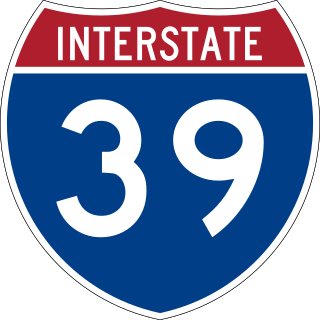
Interstate 39 (I-39) is a highway in the Midwestern United States. I-39 runs from Normal, Illinois, at I-55 to State Trunk Highway 29 (WIS 29) in the village of Rib Mountain, Wisconsin, which is approximately six miles (9.7 km) south of Wausau. I-39 was designed to replace U.S. Route 51 (US 51), which, in the early 1980s, was one of the busiest two-lane highways in the United States. I-39 was built in the 1980s and 1990s.

Interstate 43 (I-43) is a 191.55-mile-long (308.27 km) Interstate Highway located entirely within the US state of Wisconsin, connecting I-39/I-90 in Beloit with Milwaukee and I-41, U.S. Highway 41 (US 41) and US 141 in Green Bay. State Trunk Highway 32 (WIS 32) runs concurrently with I-43 in two sections and I-94, I-894, US 10, US 41, US 45, and WIS 57 overlap I-43 once each. There are no auxiliary or business routes connected to I-43, though an alternate route to direct traffic during road closures is signed along local and state highways from Milwaukee County north into Brown County.

U.S. Highway 151 (US 151) is a United States Numbered Highway that runs through the states of Iowa and Wisconsin. The southern terminus for US 151 is at a junction with Interstate 80 (I-80) in Iowa County, Iowa, and its northern terminus is at Manitowoc, Wisconsin. The route, from south to north follows a northeasterly path through the two states.

Interstate 894 (I-894) is a 9.92-mile (15.96 km) auxiliary Interstate Highway in Milwaukee County in the US state of Wisconsin. The route serves as a bypass of downtown Milwaukee, connecting with I-94 at the Zoo Interchange west of downtown and the Mitchell Interchange south of downtown. The route runs concurrently with three other highways for its duration, following US Highway 45 (US 45) from the Zoo Interchange to Hale Interchange as the Zoo Freeway, where it separates from US 45 to follow I-43 heading east to the Mitchell Interchange as the Airport Freeway. In local traffic reporting and casual conversation, it is known simply as "the bypass" or "894", with "41" also being more recently used, as I-894 is entirely concurrent with I-41/US 41. The east–west portion is also concurrent with I-43.
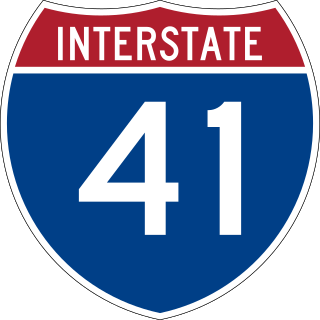
Interstate 41 (I-41) is a 175.00-mile-long (281.64 km) north–south Interstate Highway connecting the interchange of I-94 and U.S. Route 41 (US 41), located about a mile (1.6 km) south of the Wisconsin–Illinois border at the end of the Tri-State Tollway in metropolitan Chicago, to an interchange with I-43 in metropolitan Green Bay, Wisconsin. The designation travels concurrently with US 41 for its entire length, as well as portions of I-894, US 45, I-43, and sections of I-94 in Wisconsin and Illinois. The route was officially added to the Interstate Highway System on April 7, 2015, and connects Milwaukee and Green Bay with the Fox Cities.

Interstate 794 is a 3.75-mile (6.04 km) auxiliary Interstate Highway in Milwaukee County in the US state of Wisconsin. It is one of two auxiliary Interstates in the Milwaukee metropolitan area, serves the lakefront and the Port of Milwaukee, and connects downtown with the southeastern suburbs of St. Francis, Cudahy, and South Milwaukee.
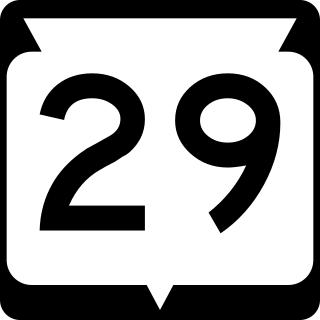
State Trunk Highway 29 is a state highway running east–west across central Wisconsin. It is a major east–west corridor connecting the Twin Cities and the Chippewa Valley with Wausau and Green Bay. A multi-year project to convert the corridor to a four-lane freeway or expressway from Elk Mound to Green Bay was completed in 2005. The remainder of WIS 29 is two-lane surface road or an urban multi-lane road.

State Trunk Highway 16 is a Wisconsin state highway running from Pewaukee across the state to La Crosse. Much of its route in the state parallels the former mainline of the Milwaukee Road and current mainline of the Canadian Pacific Railway. Interstate 90 (I-90) or I-94 parallels Highway 16 for most of its length in the state. It serves local traffic in nearby cities including La Crosse, Tomah, Wisconsin Dells, Portage, Columbus, Watertown, Oconomowoc and Waukesha. The highway is mainly two-lane surface road or urban multi-lane expressway from La Crosse to Oconomowoc, and it is a freeway east of Oconomowoc.

State Trunk Highway 312 is a 7.9-mile (12.7 km) long Wisconsin state highway running along the north side of Eau Claire, from the Town of Union in the west to the Town of Seymour in the east. The entire length of WIS 312 is an expressway with a few grade crossings.
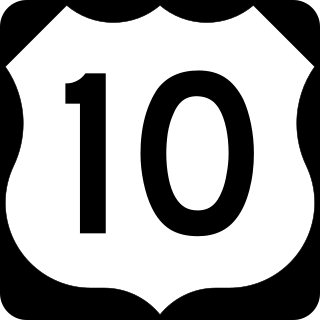
U.S. Highway 10 (US 10) in Wisconsin runs east–west across the central part of the state. It runs from the Prescott Drawbridge over the St. Croix River at Prescott east to the dock in Manitowoc where SS Badger crosses Lake Michigan to Ludington, Michigan. The highway is also designated as the Vietnam War Veterans Memorial Highway for its entire length.

State Trunk Highway 164 is a Wisconsin state highway running from Slinger, around the city of Waukesha, to Waterford.

Wisconsin Highway 57 is a 191.82-mile-long (308.70 km) state highway in Wisconsin, United States. It runs from its southern terminus at WIS 59 in Milwaukee to its northern terminus at WIS 42 in Sister Bay. Much of WIS 57 parallels Interstate 43 (I-43) and WIS 42, particularly from Saukville to its northern terminus in Sister Bay. The highway runs concurrently with I-43 for 12 miles (19 km) in Ozaukee County. Like most Wisconsin state highways, WIS 57 is maintained by the Wisconsin Department of Transportation (WisDOT).

State Trunk Highway 341, better known as Miller Park Way and currently Brewers Boulevard, refers to a former unsigned route designation of a segment of the oldest freeway in Milwaukee, Wisconsin, United States. It connects Interstate 94 (I-94) to WIS 59, with a single set of off-ramps to Canal Street and American Family Field's parking lots.

State Trunk Highway 794, officially the John R. Plewa Memorial Lake Parkway or simply the Lake Parkway, is a 4.76-mile (7.66 km) state highway in Milwaukee County, Wisconsin, United States, that goes north–south from downtown Milwaukee to its southern suburbs.

State Trunk Highway 142 is a mostly rural highway connecting Burlington with Kenosha.
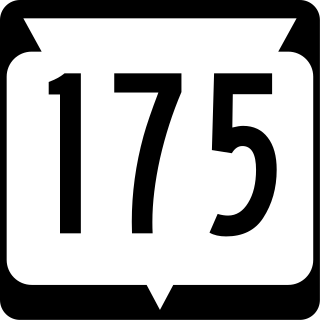
State Trunk Highway 175 is a state highway in the US state of Wisconsin. It runs north–south in central Wisconsin from West Milwaukee to just south of Fond du Lac.
The Stadium Freeway is a six-lane divided highway traveling south to north in the city of Milwaukee, Wisconsin. This freeway was the first road of its kind built in Milwaukee County. It is designated as Wisconsin Highway 175 (WI 175) along its northern stretch from WIS 59, past Interstate 94 (I-94) to Lisbon Avenue.
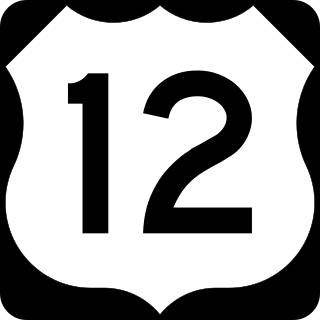
U.S. Highway 12 in the U.S. state of Wisconsin runs east–west across the western to southeast portions of the state. It enters from Minnesota running concurrently with Interstate 94 (I-94) at Hudson, parallels the Interstate to Wisconsin Dells, and provides local access to cities such as Menomonie, Eau Claire, Black River Falls, Tomah, and Mauston. It then provides an alternative route for traffic between northwestern Wisconsin and Madison and is the anchor route for the Beltline Highway around Madison. Finally, it serves southeastern Wisconsin, connecting Madison with Fort Atkinson, Whitewater, Elkhorn, and Lake Geneva. The West Beltline Highway and the segment between Elkhorn and Genoa City are freeways, and the segment between Sauk City and Middleton is an expressway. The remainder of the road is a two-lane surface road or an urban multilane arterial. Between Hudson and west of Warrens, the road closely parallels the former main line of the Chicago, St. Paul, Minneapolis and Omaha Railway, now operated by Union Pacific Railroad.

The Great Lakes Circle Tour is a designated scenic road system connecting all of the Great Lakes and the St. Lawrence River. It consists of routes for circumnavigating the lakes, either individually or collectively. It was designated by the Great Lakes Commission in 1988.

In Milwaukee, freeways were constructed in response to an 8.5% increase in population during the 1940s. Road plans were drawn up in the 1950s through the 1970s and several freeways were built. A lack of foresight resulted in several communities experiencing sharp increases in property taxes such as in West Milwaukee, or the complete destruction of vibrant, African-American neighborhoods such as Bronzeville. After a decade of aggressive highway building in the 1960s, support for freeway construction began to wane as neighborhoods started to oppose construction. With the election of John Norquist as mayor in 1988, Milwaukee began to undo some of the damage of its highway construction. The dismantling of the Park East Freeway north of downtown led to a housing and entertainment construction boom and is the location of Fiserv Forum.




















